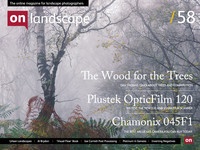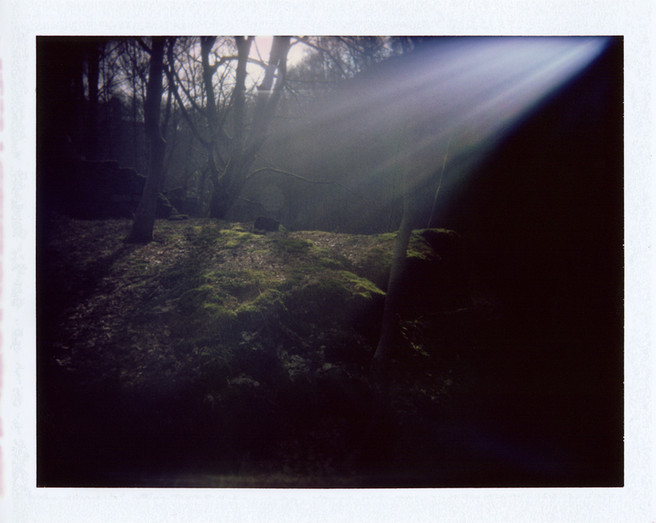Featured Photographer

Tim Parkin
Amateur Photographer who plays with big cameras and film when in between digital photographs.

Al Brydon
I'm a photographer based in the north of the UK working on long term landscape photography projects. I have been published and exhibited both in the UK and abroad and am co-founder of the Inside the Outside photography collective.
Landscape photography is the perfect vehicle for narrative and storytelling. I'm interested in the history of landscape and human interaction and alteration of landscape. The long departed people who have shaped that world sing songs. I'm slowly learning to listen.
This issue's Featured Photographer is an old contributor Al Brydon. Al has been intriguing us with his crepuscular concoctions for a while and we wanted to ask him some of the usual questions and get an update on this and his 'two photographers' Holga experiments.
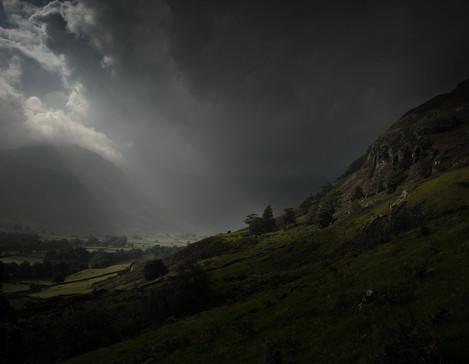 Can you tell me a little about your education, childhood passions, early exposure to photography and vocation?
Can you tell me a little about your education, childhood passions, early exposure to photography and vocation?
As a small boy I was surrounded by strange boxes of junk my dad would buy at auction for a quid a box. Aside from old radios and general detritus, there would occasionally be a very old camera for which the old man would get some film. I would then set my toy dinosaurs into a makeshift garden diorama and photograph them in various stages of a battle. Many years later when I was sixteen I attended Chesterfield Art College and used a darkroom for the first time. Seeing my first image appear in the developer was the moment, as it were. Even though I knew an image would appear I was still surprised when it did. It was really then that I knew what I wanted to do so I started a HND in photography at Leicester College and then completed a further 6 months study at the now sadly defunct Picture House. All these years later thankfully I'm still being surprised by photography
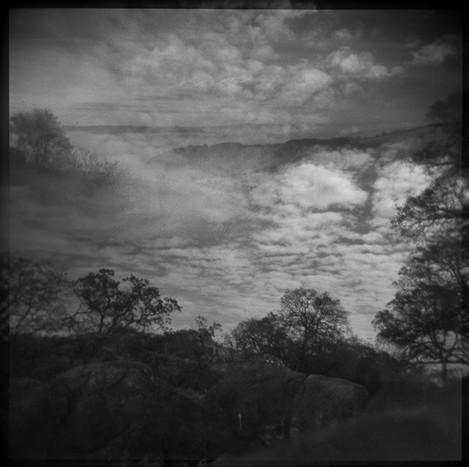 What are you most proud of in your photography?
What are you most proud of in your photography?
Whatever I'm currently working on. Once a project is finished it's finished and I want to move on. I find it increasingly difficult to look back at older work and still remember how I felt about it at the time. Retrospective revelations about what I was thinking can be fairly illuminating and may then influence the next set of photographs. Building upon old ideas and taking them somewhere else seems to have allowed an evolution to the work. Mentally I always feel six months behind each project. I make the photographs then work out why afterwards.
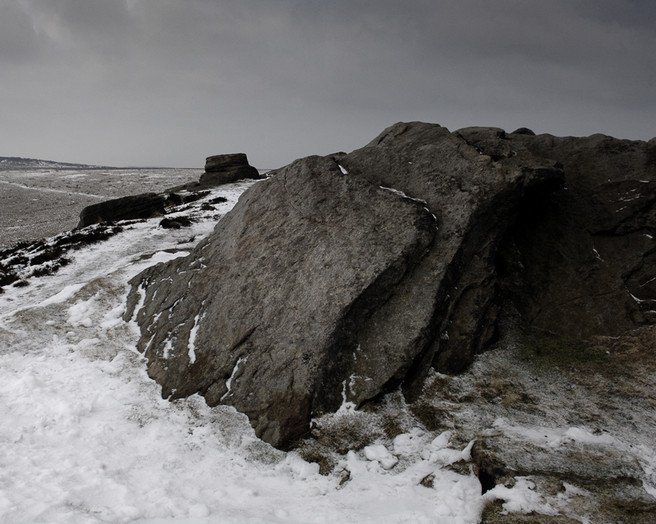 In most photographers lives there are 'epiphanic’ moments where things become clear, or new directions are formed. What were your two main moments and how did they change your photography?
In most photographers lives there are 'epiphanic’ moments where things become clear, or new directions are formed. What were your two main moments and how did they change your photography?
“Downgrading” to the Holga (toy camera with a fixed focal length plastic lens) was a fantastically liberating experience. The sudden absence of technology forced me to approach landscape photography in a completely different way. One shutter button and a focus ring that seemed to make no discernible difference no matter which way it's twiddled offered a complete oneness with the subject matter in front of me. I found it was something I could apply to my other landscape work with relative ease after a while. The other revelation came from mostly shooting in fairly awful weather conditions. No sunshine or chocolate box photographs, not that I have anything against that type of photography but it just doesn't interest me. The landscape is a tactile environment, especially on a rainy or windy day. There's so much more going on and the harder I have to work to get an image and the more I lose my sense of humour the more interesting the result seems to me. I want to have to work hard; it should never be easy.
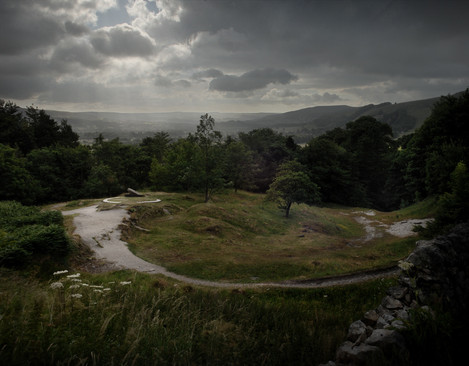 Tell me about why you love landscape photography? A little background on what your first passions were, what you studied and what job you ended up doing
Tell me about why you love landscape photography? A little background on what your first passions were, what you studied and what job you ended up doing
One of the unifying themes of humankind is a desire to be understood. I think photographs, whether we realise it at the time or not, are the visual aids to do just that. Just on an elementary level, we are saying 'here is something I want to share with you'. Photographing the landscape for me is like finding your place in the universe. The locations become like friends or sometimes enemies and it's continually comforting to know these places should still be here long after I'm gone. On top of a hill in the wind and rain is where I personally find a clarity that has always alluded me in other aspects of my life. I think that passion for your surroundings comes across in the work you produce.
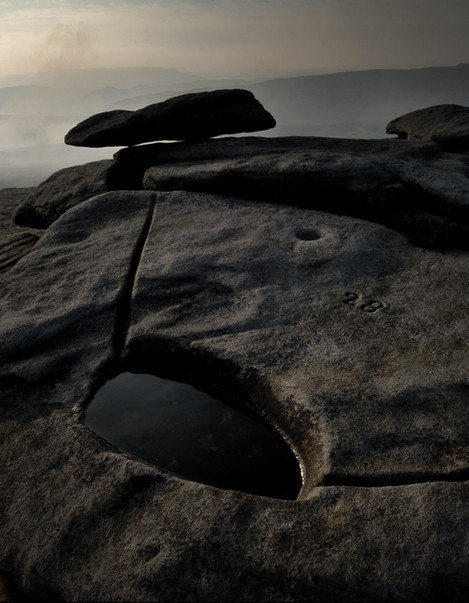 Could you tell us a little about the cameras and lenses you typically take on a trip and how they affect your photography?
Could you tell us a little about the cameras and lenses you typically take on a trip and how they affect your photography?
Absolutely not!
Only kidding. I use a nearly dead Nikon D2xs and a 17-55 f2.8 lens. Other times a 50 mm prime if my shoulders feel like they’ve separated. I also use the aforementioned Holga for which I've just procured a Polaroid back. I want simplicity and ergonomic familiarity due to my technical buffoonery and a need to be totally focused on what’s happening in front of me. More buttons equals more distractions.
What sort of post processing do you undertake on your pictures? Give me an idea of your workflow.
I shoot Raw and convert to tiffs using Capture NX for a soft edit. Any cropping will be done then too. Then it's into Photoshop for tweaking. A lot of my work is dark and I tend to underexpose at the time of shooting to emphasise this. I also tend to desaturate the photographs. Colour for me can be very distracting and I want to accentuate the composition and textural nature of the photograph without too much colour getting in the way. This combination seems to work best for my current landscape work which is largely based around the Peak District.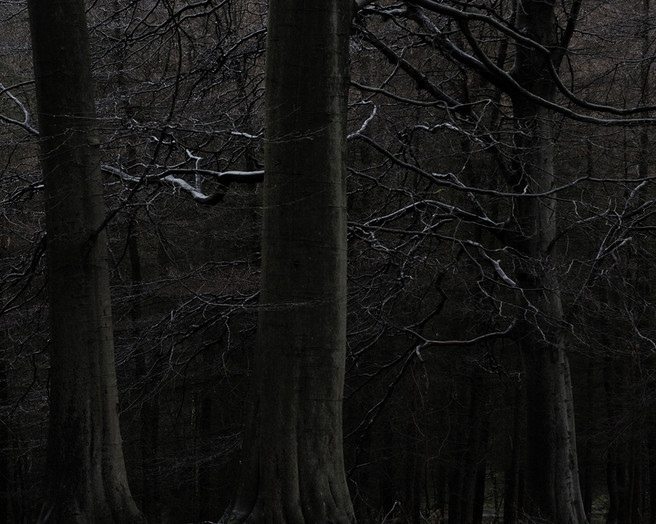 Do you get many of your pictures printed and, if at all, where/how do you get them printed?
Do you get many of your pictures printed and, if at all, where/how do you get them printed?
I do get quite a lot of work printed, but rarely for myself. I haven't used a darkroom for about ten years but will endeavour to get back into one at some point to print my own work again. I found the darkroom experience invaluable in my later conversion to a mostly digital workflow. I'm sure most of you will have printed in a darkroom at some point but if you haven’t I would urge you to give it a go. The lab I use for all my current printing needs is Peak Imaging in Sheffield.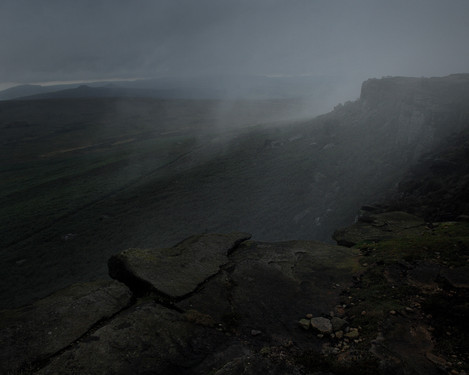 Tell me about the photographers that inspire you most. What books stimulated your interest in photography and who drove you forward, directly or indirectly, as you developed?
Tell me about the photographers that inspire you most. What books stimulated your interest in photography and who drove you forward, directly or indirectly, as you developed?
Ragnar Axelsson, Susan Lipper, Don McCullin (especially his landscape work) and Richard Billingham. Each of these photographers has had a very profound effect on my work. I want to evoke the same response in the person viewing the photographs as the above photographers made me feel. Darkness but with obvious affection. However I suppose, somewhat oddly, the inspiration for my landscapes doesn’t often come from looking at other landscape photographers, for example, William Blake and J. M. W. Turner have had an effect too and need a mention. The person that I think gave me the most help was my first college lecturer Andy Dolan and the rest of the team in the Chesterfield Art College photography department. They made photography instantly interesting.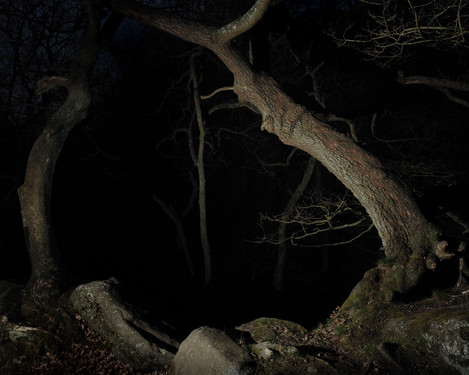 Tell me what your favourite two or three photographs are and a little bit about them.
Tell me what your favourite two or three photographs are and a little bit about them.
They would really have to be from the nightscapes series, certainly in terms of making the photographs. Standing in the middle of nowhere at night on my own proved to be a unique and slightly terrifying experience. From this series, I love the B29 Bomber wreck photographs the most. It is one of the most sombre and dark places that I've ever been to and photographing it at night was one of the most moving and amazing photographic experiences I've ever had.
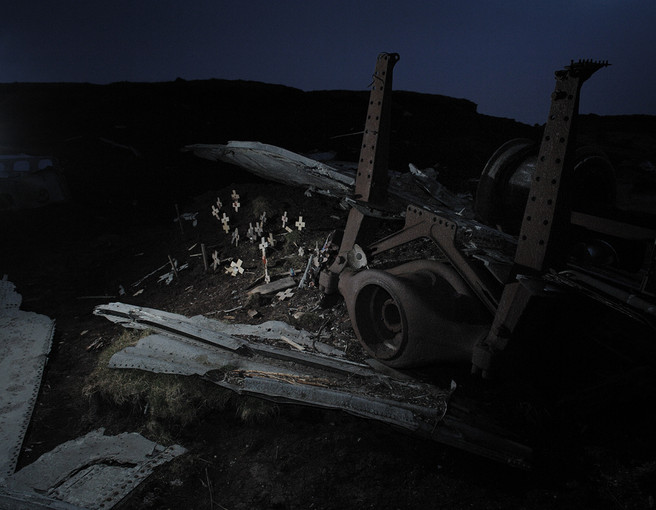 Even though I was with two other people, being surrounded by that terrible wreckage as the light began to fade was one of the loneliest and saddest moments I've had whilst making photographs. Human tragedy and that particular landscape seemed to blend together almost too willingly. It was horrifying and beautiful at the same time. I didn't feel bad about making the images, it seemed to be the most natural activity to do at the time. I think while looking through the viewfinder it's easy to feel shielded in some ways. It's when I put the camera down and turned to leave that I realised I would have to confront my own reactions to what I had just photographed. To this day it still seems like a long walk back.
Even though I was with two other people, being surrounded by that terrible wreckage as the light began to fade was one of the loneliest and saddest moments I've had whilst making photographs. Human tragedy and that particular landscape seemed to blend together almost too willingly. It was horrifying and beautiful at the same time. I didn't feel bad about making the images, it seemed to be the most natural activity to do at the time. I think while looking through the viewfinder it's easy to feel shielded in some ways. It's when I put the camera down and turned to leave that I realised I would have to confront my own reactions to what I had just photographed. To this day it still seems like a long walk back.
Could you tell me a bit more about the two projects you've worked on recently?
The Dark Project.
These particular photographs were made over the last couple of years. It's an ongoing project that I'm trying to work out how to wrap up but seem unwilling or unable to stop.
The photographs started to take on a slightly darker edge without me really thinking about it. I soon started to realise that when I was making the photographs, I was alone and sometimes somewhere fairly remote. It was in the moments leading up to actually pressing the shutter I began to notice a general unease. It felt like my presence there in the landscape was merely being tolerated and could be revoked at any time. These places seemed to be alive and I tried to absorb the sadness and accentuate the interconnectivity between me, the viewer and the landscape itself. I started to think about how we as humans make the landscape what it is. We must be the only species who will stop and think to ourselves how the light looks today, how the weather alters the mood of a place. To appreciate a location for whatever personal reason yet realise we are just guests. Now I always imagine a huge 'Not Welcome' sign suspended above every place I want to photograph. It seems to be doing the trick.
The Holga Collaboration.
A fellow photographer J.M Golding from the US was using toy cameras and making double exposures with some other photographers to great effect. We were aware of each other's work and after some correspondence decided we would have a go at working with each other. The premise was this. We would each expose a roll of film through our identical Holga cameras. Once finished the roll would be rewound and posted to the other photographer. We then re-exposed the others film. California and the Peak District blended.
The title of the project is 'Tales from a non-existent land'. We were trying to create our own landscape, a sort of photographic escapism. We were obviously quite frustrated with the photographic world and wanted to create something very insular the contradiction being we really wanted people to view these photographs and feel what we were feeling. It felt like these pictures were a direct response to the sheer amount of imagery we are bombarded with on a daily basis, with absolutely no hope of having the time to view them. These were just for us and if other people wanted to look they were more than welcome.
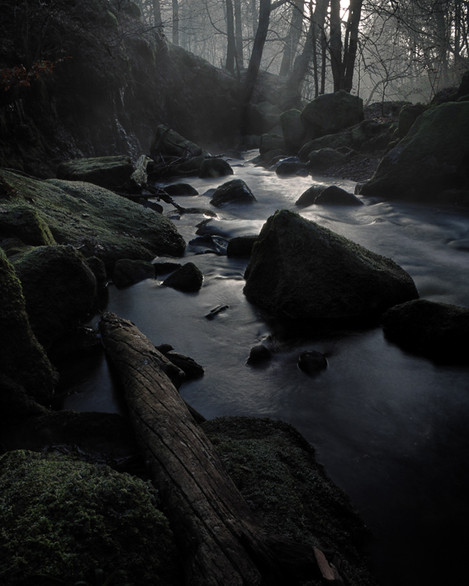 If you were told you couldn’t do anything photography related for a week, what would you end up doing (i.e. Do you have a hobby other than photography..)
If you were told you couldn’t do anything photography related for a week, what would you end up doing (i.e. Do you have a hobby other than photography..)
All extracurricular activities have been put on hold since the birth of my son. If he wasn't so demanding I've got a stack of books to read and walking to do. Going out without a camera is sometimes a good thing for me to do. To take pleasure in my surroundings and enjoy the fact I'm able to be outside when the mood takes me is a fairly constant joy. I always go back with my camera at a later date.
What sorts of things do you think might challenge you in the future or do you have any photographs or styles that you want to investigate? Where do you see your photography going in terms of subject and style?
I'm beginning to formulate another night series project based around the coastal regions of the UK. I ended up on the Norfolk coast last year shooting at night using various light sources, typically making between three to five images during the evening. I enjoyed it so much I've promised myself a series of return visits. I found Norfolk an extremely challenging yet interesting place to photograph and I fell in love with the tidal mudflats and the objects revealed when the tide was out. Night-time shooting made it even more surreal.
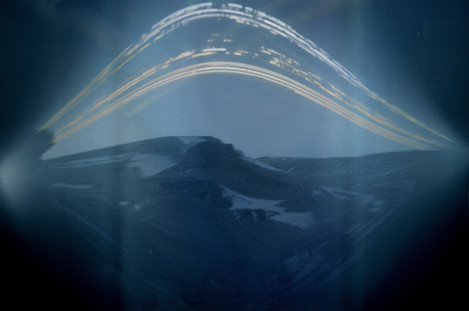
Closer to home I would like to expand on a shoot I did last year. I was able to photograph a family of Peak District hill farmers for a day during their late lambing. Even over such a short period of time I became fascinated with lives totally different to my own though it was obvious very quickly we had a lot in common regarding our feelings of belonging to the landscape. It was a privilege to be invited into their world and I would relish the chance to make more photographs of other people working within the Peak District. The landscape shapes people and I like the feeling of being an observer but also an active participant in this particular part of the world.
Who do you think we should feature as our next photographer?
Rob Hudson or Brian David Stevens.
Thanks to Al for that! Great work and refreshing to see an alternative take on the landscape.

